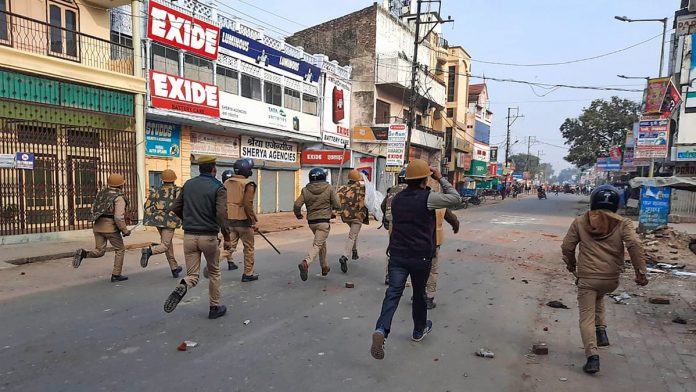
Traveling along the Muzaffarnagar countryside roads in 2013 with a group of concerned citizens soon after the horrific violence in the Muzaffarnagar area, we stopped by what looked like a makeshift refugee camp a certain distance from the road. Some elders of the community came up to us and invited us to a small tent they had set up by the roadside, evidently to interact with visitors. One of them tossed sugarcane sticks to each one of us to chew on as a sign of hospitality. This was sugarcane country after all. The sugarcane was full of sweet juice as we hungrily stripped off its layers with our teeth.
But as we realized, the natural welcome and camaraderie, despite the trauma and displacement suffered by the community, was what had overwhelmed us; that was the sweetness that filled us.
As court cases dragged on and the indictments of the accused grew into a tortured political affair, especially after the BJP-government came into power, we heard of how entire families (some of them were witnesses in the court cases) had moved residence from Muzaffarnagar and were untraceable.
Cut to 2019 and Muzaffarnagar, along with several other parts of UP, is in the news again for violence against its Muslim residents. At least two fact-finding reports reveal the excesses of law-enforcement in dealing with the anti-CAA protests. As one member of one of the team’s stated, “We got reports that all private hospitals in Meerut and Muzaffarnagar were strictly instructed by the police not to admit people with bullet injuries. They were admitted only in government hospitals, where families of the victims were not allowed to meet them at all.”
Another fact-finding team member narrated “an account of a postgraduate who ‘lies in a shattered room of her grandfather Hamid Hasan’s house in Jaswantpuri, Barafkhana in Muzaffarnagar.’
‘Her forehead is bandaged, covering a deep gash caused by a steel rod. In the next bed is her 14-year-old brother, his eyes still terrified, his body bruised. Both were beaten up by the police on 20 December 2019,’” the activist said.
This is certainly very disturbing since several people, including those from the majority community, reported that some of the protests, especially in the Meenakshi Chowk area of Muzaffarnagar, were not sampradayik (communal) in nature, as reported in the Hindi daily, Dainik Hindustan. Yet, it was the Muslims who were brutally targeted.
One knows the story of polarisation in areas of western UP, including Muzaffarnagar, as reported by many journalists, including The Hindu’s Vidya Subrahmaniam. The story of how the seeds of communal distrust were sown over a period of time between the Jats and the Muslims of the region, especially right after the 2013 riots and before the 2014 general elections. How, one by one, all of the accused in the rioting were released. How, even several years after the riots, the riot-affected, the Muslims, were left to languish in the few relief camps that remained.
For the Mulsims of Muzaffarnagar and elsewhere in UP, especially western UP, so traumatised and demonised by the 2013 violence, the police also acting as a communal, marauding force will surely shake them to the core. As one of the victims of the police rampage in Muzaffarnagar told the fact-finding team, “every assailant was a policeman, all in uniform.”
The UP police has been communal from a very long time, specially the PAC (Provincial Armed Constabulary), which was one of the forces present in Muzaffarnagar. Its repressive role during the Uttarakhand statehood struggle (Rampur Tiraha) is well known as is its role in the Hashimpura massacre.
However, the police act on orders, or they are supposed to. Trying to review the situation across UP, one cannot help but be struck by the repressive nature of the UP police in quelling the protests, often by violent means, and with loss of life and limb for Muslims. It would be difficult not to connect their actions with the mandate and mentality for “revenge,” as expressed by UP’s chief minister, Yogi Adityanath. This revenge took many forms – the firing of live bullets and the terrorising of the Muslims was just one tactic. Actual damage costs being sent to supposed “rioters,” and the use of “naming and shaming,” of those it deemed as provocateurs – of course, Muslims – were other shameful techniques.
The UP state administration’s actions, similarly, cannot be seen as unconnected to the consensus and attitude of the ruling BJP of the nature of the protests. The so-called leader of the nation, prime minister Narendra Modi spoke about the dress of the protesters as revealing their identity, making a barely-concealed and despicable accusation against Muslims. The Finance Minister Nirmala Sitharaman in her clueless manner blurted that jihadists and the Maoists were behind the protests.
If one observes such recklessness and crudity of discourse from its political leaders, how can one expect that not to translate to the language of bigotry, intimidation and violation against those they casually tar, the Muslims?
The people who offered us sugarcanes had little left from the 2013 Muzaffarnagar riots which had made them homeless. Yet, they knew the sugar-sweet language of brotherhood and common humanity. They instinctively shared what little they had left. Their generosity of spirit and their fortitude could rise above the injustice meted out to them for no fault of theirs. The Muslims of Muzaffarnagar have seen many hard knocks over the years. But like the hardy cane, till now they seem to have withstood all that has come their way. One can only hope that their sweetness never runs dry.
The author is a student of social movements. He has been involved in various struggles of the marginalized people, including Dalit and Adivasi movements and the Palestinian struggle.